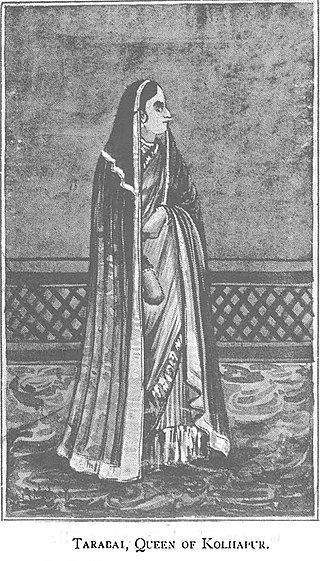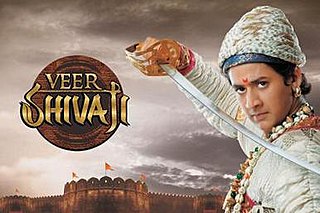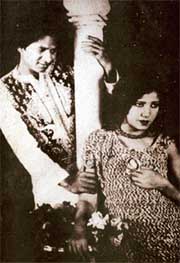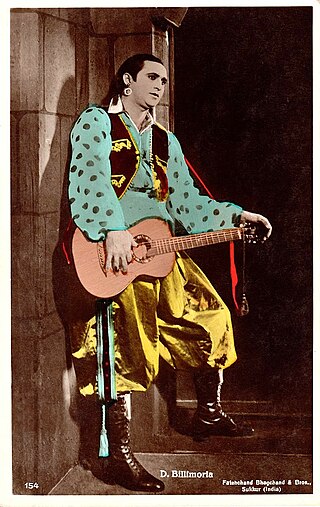Related Research Articles

Sambhaji, also known as Shambhuraje was the second Chhatrapati of the Maratha Kingdom, ruling from 1681 to 1689. He was the eldest son of Shivaji, the founder of the Maratha Kingdom. Sambhaji's rule was largely shaped by the ongoing wars between the Marathas and the Mughal Empire, as well as other neighbouring powers such as the Abyssinians of Janjira, Wadiyars of Mysore and the Portuguese Empire in Goa. After Sambhaji's execution by Aurangzeb, his brother Rajaram I succeeded him as the next Chhatrapati and continued the Mughal–Maratha Wars.

Chhatrapati is a royal title from Sanskrit used to denote an emperor. The word "Chhatrapati" is a Sanskrit language compound word of chhatra and pati (master/lord/ruler). This title was used by the House of Bhonsle, between 1674 and 1818, as the heads of state of the Maratha Confederacy.

Jijabai (or Bhonsale, Bhosale, Bhosle) or Jadhav, referred to as Rajmata, Rastramata, Jijabai, Jijamata or Jijau, was the mother of Chattrapati Shivaji, founder of the Maratha Empire. She was a daughter of Lakhujirao Jadhav of Sindkhed Raja.
Moropant Trimbak Pingale (1620–1683), was the first peshwa of the Maratha Empire, serving on Shivaji Maharaj's Ashta Pradhan.

Shahu I was the fifth Chhatrapati of the Maratha Confederacy founded by his grandfather, Shivaji I. He was born into the Bhonsle family, and was the son of Sambhaji I and Yesubai. At a young age, he was taken into custody at the Siege of Raigad by Mughal emperor Aurangzeb, and held captive. He was released from captivity after the death of Aurangzeb in the hope of engineering an internecine struggle among the Maratha factions of Tarabai and Shahu. Shahu emerged victorious in the bloody Battle of Khed and was crowned as Chhatrapati.

Tarabai Bhosale (née Mohite) was the regent of the Maratha Empire from 1700 until 1708. She was the queen of Rajaram I, and daughter-in-law of the empire's founder Shivaji I. She is acclaimed for her role in keeping alive the resistance against Mughal occupation of Maratha territories after the death of her husband, and acting as the regent during the minority of her son, Shivaji II and defeated Aurangazeb
Hambirrao Mohite also known as Hansaji, was a prominent Maratha general who held the esteemed position of the 5th Senapati of the Maratha Army during the reign of Chhatrapati Shivaji. He was recognized for his exceptional military prowess and successfully led various campaigns on behalf of Shivaji, subsequently continuing his service under Chhatrapati Sambhaji.
Rajmatoshree Shrimant Soyarabai Saheb Bhosale(Mohite) died 1681) was second wife of Shivaji Maharaj, the founder of Maratha empire in western India. She was mother of Shivaji Maharaj's second son, Rajaram. She was the younger sister of Maratha army chief Hambirrao Mohite.
Sangameshwar Taluka is a taluka in Ratnagiri subdivision of Ratnagiri district in the Indian state of Maharashtra. The headquarters for the taluka is the town of Devrukh. In Sangameshwar the two rivers Sonavi and Shastri flow together. The meaning of Sangama in Marathi is "confluence," and so the name "Sangameshwar". It is historically important as the place where Chhatrapati Sambhaji, son of Chhatrapati Shivaji was captured by Mughal Emperor Aurangzeb. Chhatrapati Sambhaji was tortured and executed in Tulapur.

Saibai Bhosale was the first wife and chief consort of Chattrapati Shivaji, the founder of the Maratha Empire. She was the mother of her husband's successor Chattrapati Sambhaji.

Kolhapur State or Kolhapur Kingdom (1710–1949) was a Maratha princely State of India, under the Deccan Division of the Bombay Presidency, and later the Deccan States Agency. It was considered the most important of the Maratha principalities with the others being Baroda State, Gwalior State and Indore State. Its rulers, of the Bhonsle dynasty, were entitled to a 19-gun salute – thus Kolhapur was also known as a 19-gun state. The state flag was a swallow-tailed saffron pennant.

Veer Shivaji is an Indian historical drama series that aired on Colors TV. The show focuses on the life of Shivaji, the 17th century founder of the Maratha Empire. It premiered on 2 September 2011 and was produced by Contiloe Telefilms, who had earlier created the historical drama Jhansi Ki Rani on Zee TV. Due to the instant success and popularity and with TRP of more than 2.60, the show timing were extended to five days a week from 3 October 2011.

Master Vithal or Vithal (1906-1969) was an actor in Indian cinema, best known as the hero of India's first talkie Alam Ara (1931) and of Marathi and Hindi silent stunt films, which gave him the epithet as the Douglas Fairbanks of India.

Sambhaji II or Sambhaji I of Kolhapur was a Raja of Kolhapur from Bhonsle dynasty. He was a grandson of Shivaji and the second son of Chhatrapati Rajaram with his second wife, Rajasbai. After defeat by Shahu, Sambhaji's stepmother, Tarabai then set up a rival court in Kolhapur with her son Shivaji II as Raja of Kolhapur in 1710, who then ruled as Shivaji I of Kolhapur line. However, in 1714, Rajasbai instigated a coup against Tarabai and installed her own son, Sambhaji II on the Kolhapur throne. Sambhaji ruled from 1714 to 1760.

Dinshaw Billimoria was an Indian actor and director.

Amol Ramsing Kolhe is an Indian actor turned politician who is the current Member of Parliament in the Lok Sabha from Shirur and member of the Nationalist Congress Party.
Sambhaji or Chhatrapati Sambhaji was the eldest son of Shivaji and the second ruler of the Maratha kingdom.
Maharani Yesubai Bhonsale was the wife of Sambhaji, and referred to as Chatrapati Maharani of the Maratha Kingdom. She was also the mother of Shahu I. Sambhaji had shared with her his power as the emperor. When Sambhaji was away from the Maratha capital due to battles, all the political decisions were made by her. After Jijabai she is Kulmuktyar of Swarajya. After the execution of Sambhaji by Aurangzeb, she announced Rajaram as the next Chhatrapati of Swarajya. The Mughal Empire captured Raigad in November 1689 and arrested Maharani Yesubai and Shahu. The Mughals kept Maharani Yesubai captive to ensure that Shahu adhered to the terms of his release. She was released in 1719 when the Marathas became strong under Shahu and Peshwa Balaji Vishwanath.
Chhatrapati Sambhaji is a 1934 Indian Marathi-language historical film directed by Parshwanath Altekar, from a story and screenplay by D. K. Kane. The film stars Master Vithal, Dada Salvi, Vasantrao Pahelwan, Javadekar, Vijayadevi, Shakuntala, Kishori Ingle, Shahir Nanivadekar, Varne, Kamble, Patil.
References
- ↑ Verma, R. K. (2000). Filmography: Silent Cinema, 1913-1934. M. Verma. ISBN 978-81-7525-224-0.
- ↑ Sainik Samachar. Director of Public Relations, Ministry of Defence. 1993.
- ↑ Raj, Ashok (1 November 2009). Hero Vol.1. Hay House, Inc. ISBN 978-93-81398-02-9.
- ↑ "Chhatrapati Sambhaji". Cinemaazi. Retrieved 3 March 2024.